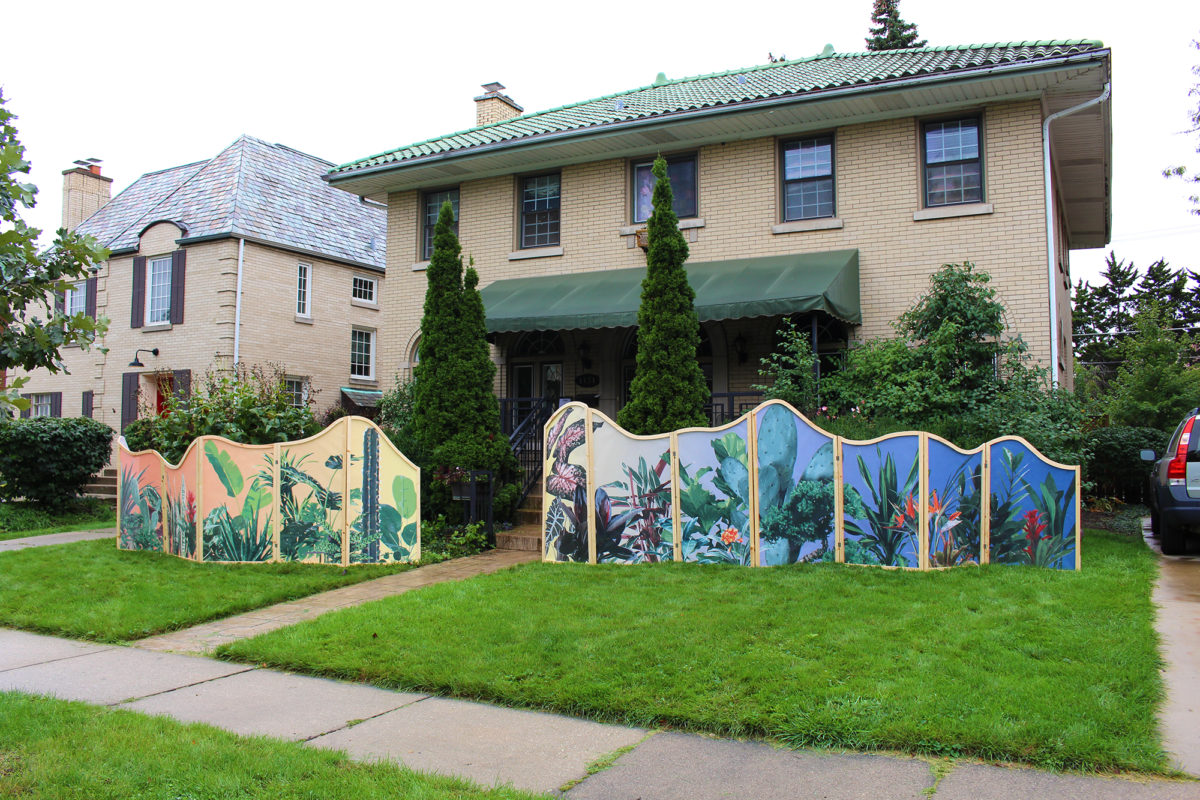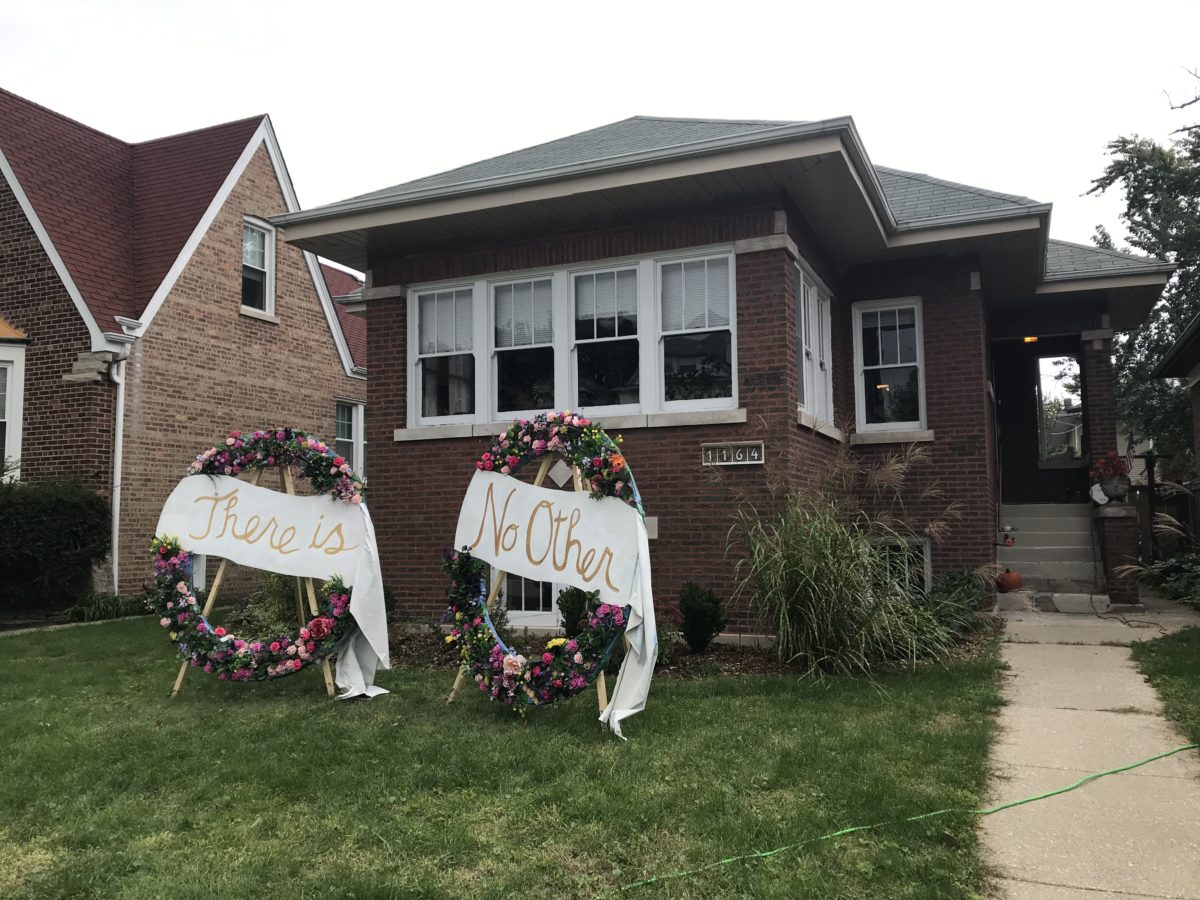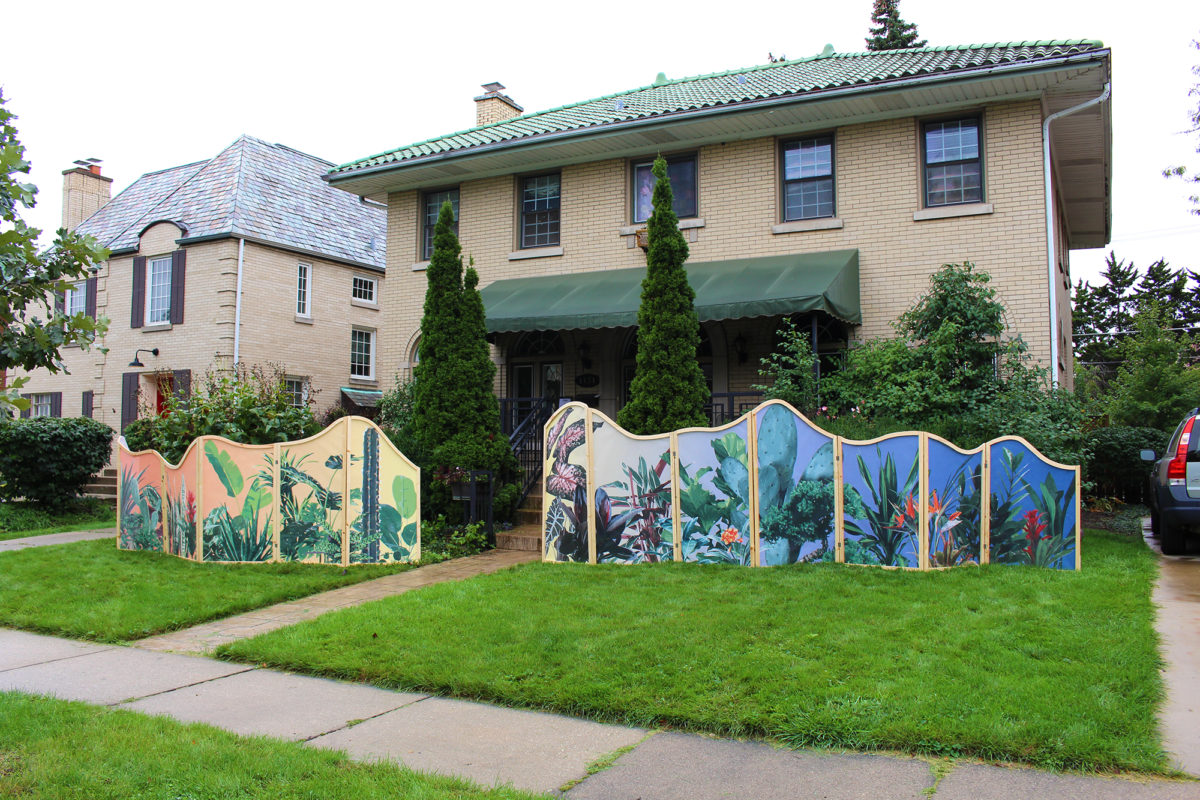[ad_1]

Work by Marina Peng and Rebecca Youn in the Terrain Biennial.
COURTESY THE ARTIST
The Chicago suburb of Oak Park is lined with verdant lawns, many of them dotted with ornaments or “Black Lives Matter” signs. For the next six weeks, however, more unusual decor can be spotted outside several homes: a geodesic dome here, an abstract assemblage there, a bulbous inflatable lodged in an alley. These weatherproof objects are part of the fourth Terrain Biennial, which opened this past weekend, with installations by over 250 artists showing exclusively in the public-facing areas of private homes, including front yards, facades, and windows.
Terrain’s founder, the late artist Sabina Ott, developed the biennial in 2011 through a gallery she ran from her porch in Oak Park, which remains the exhibition’s nucleus. This edition, organized by a new board of directors, is more expansive than previous versions, with satellite sites in Chicago proper, Los Angeles, London, Portland, Maine, and even faraway locales like Havana, Cuba, and Dhaka, Bangladesh. To visit, locals just have to show up outside host homes—no ticket or appointment is required. (While the diffuse nature of the show means that crowds are unlikely, expect to see dads pushing lawnmowers and kids on bikes.)
The premise of the biennial, which largely spotlights local artists, rests on an anti-institutional, community-first ethos that has long driven Chicago’s rich history of artist-run spaces. But it also playfully mines a more universal tendency. “People use their houses as expressions of their identity in a variety of different ways, from political slogans to holiday decorations,” Tom Burtonwood, a biennial board member, said. “Terrain is a continuation of that history and vernacular.”
This year’s participants—which, like their hosts, are selected through an open call process—were asked to reflect on environmental change. Naturally, foliage was a common motif in projects. In Oak Park, Aimée Beaubien covered the pistachio-colored facade of her host’s house with an iridescent collage of photographs documenting leaves from her own home. Woven together with paracord, they form a radiant vine—a symbol of tenacity amid shifting ecological conditions. “The inkjet prints will continue to curl,” Beaubien said, “much like leaves crumpling up before falling.”
Elsewhere, collaborators Marina Peng and Rachel Youn riff on the American dream of white picket fences with a 12-panel folding screen adorned with imagery of desert plants. The ornamentation, baroque and begging to be Instagrammed, skewers insatiable consumer cravings for trendy non-native flora. Meanwhile, discarded plant blooms are materials for Rebecca Ann Keller, who repurposed them to build a pair of 6-foot-tall wreaths. Draped with banners that read, “There is No Other,” they are melancholic greetings to passersby, standing as cautionary memorials for a dying planet.

Rebecca Keller, There Is No Other, 2019.
CLAIRE VOON/ARTNEWS
Other contributions are harder to spot, as they nearly blend in with their surroundings. (With Halloween fast approaching, one would be forgiven for thinking some works are spooky decorations.) It would be easy to walk right by Paola Cabal’s tribute to Ott, which traces the shadow cast by a sapling planted by Ott’s husband. (The artist died in 2018 at the age of 62.) Painted on Tyvek attached to the dirt, the dark marks are a poetic symbol of the late artist’s spreading influence on Chicago’s art community.
Just five blocks south, Kelly Kristin Jones’s Native Guard is an effective study in the power of camouflage. On a lawn sit three papier mâché mounds of photographs of foliage. Only when you read an accompanying text (slipped into a brochure holder) does it become clear that each is a mold of a local historical marker. Jones has been making work around monuments that commemorate racist white men for three years, initially focusing on those in the South when she lived in Georgia. Now based in Chicago, she photographs the surroundings of local sites that honor what she describes as “false and/or violent histories,” and uses edited imagery to digitally “erase” or “heal” the landscape. “Whether such monuments are finally taken out of our public spaces or not, they will forever haunt both our narrative and our land,” Jones said. When Terrain ends, on November 7, she intends to sheathe the original monuments with the molds.
In the suburb of Evanston, several more homes become political sites. Unwieldy sculptures that Óscar González-Diaz fashioned out of a concrete material used for refugee shelters slump on a well-manicured lawn like languishing baggage. Sonja Thomsen’s own sanctuary, a plywood dome decorated with enlarged fragments from the U.S. Constitution, serves as a sunny site to contemplate the current state of democracy. And winding along one street corner is a neon banner by the collective Pixelface, inscribed with messages of solidarity for marginalized groups, such as immigrants, the LGBTQ community, and incarcerated individuals.
The scope of Terrain may overwhelm visitors—especially those who don’t have cars. Relying on public transportation and two feet, I could explore only the Oak Park and Evanston sites over a single weekend. Could all this travel deter art lovers in the Chicago area from seeing every work in this vicinity? Burtonwood said, “Something we’ve been wondering is: Are we a middle-class art project? Is there a barrier to see the work if you don’t have a car? Or is there a barrier to participation? Do you have to have a house or nice landlord? I’m not sure what the answer is.”
A car or bicycle may be helpful when navigating this year’s biennial; a map could probably come in handy, too. But Terrain’s charm lies in the delight of happening upon art in the wild, be it sculptures hidden away in shrubbery or cyanotypes waving from a brick wall. Ott was “super focused on the idea of the accidental viewer—the passerby going to school or the store who would happen upon art,” Burtonwood said, adding that the biennial doesn’t ask much of the public. In other words, people simply have to leave their homes and keep their eyes open.
[ad_2]
Source link

